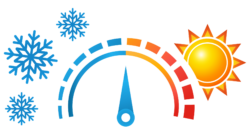It’s okay to lose money during the summer…right?
Have we grown so accustomed to profiting only in the winter that we accept controllable losses during the summer? The delivery business in June is very different from January; doesn’t it seem odd that summer deliveries are much smaller?
Navigating Delivery Challenges
Limiting runouts is crucial, but this has boundaries: small deliveries aren’t profitable (enough), while those that are too big run the risk of expensive runouts.
It’s all about the ITL
The answer to the uncertainty of “getting it right” is to have consistently accurate In-tank levels (ITL). Accurate ITLs allow you to manage resources efficiently, ensuring deliveries are large enough to be profitable but not so large they increase the risk of runouts.
Your Back Office System’s Role
A Back-office System (“BOS”) does a great job of calculating consumption formulaically using basic math. On one hand, there is a numerator representing Heating-Degree Days (“HDDs”) and on the other a denominator representing the K-factor. Numerator over denominator equals consumption, and yesterday’s ITL minus consumption equals today’s ITL.
For example, if a tank were filled to 250 gallons, had a K-factor of 3, and the day had 30 HDD’s, the ITL would go from 250 gallons to 240 gallons (30 / 3 = 10 gallons).
Summer Calculations
Winter calculations are straightforward, but summer, with few (or no) HDDs, requires a different approach. Your BOS still needs a numerator and denominator to calculate consumption during seasonal transitions and for hot water use. These “summer HDDs” and “seasonal Ks” help, but their accuracy depends on timely seasonal switches. These “summer HDDs” and “seasonal Ks” are helpful, but their accuracy depends upon whether the switch is made at the right time.
Timing the Seasonal Switch
Pushing the winter-to-summer switch too late can result in overestimating consumption, yielding smaller deliveries from the spring through the fall – especially if there is a mild spring. Switching too early can result in larger deliveries than desired – especially if there are unseasonably cold days.
Unseasonable weather disrupts ITL accuracy even with the best BOS calculations.
What can you do?
- Monitor Your BOS Data: You have all the information in your BOS and (should) know when you are delivering early.
- Recalibrate Plans: Use your BOS data to identify when consumption is being underestimated or overestimated and adjust your plans during the summer.
- Optimize Deliveries: Consumption calculations, and the resultant ITL, are usually excellent for most of the winter, but they can be very suspect from April through November. If you manage your summer correctly, you could save a full delivery per tank per year.
Yes, you have as many delivery trucks as you need. Yes, you likely have more drivers than you know what to do with. However, neither is an excuse to make small deliveries. By correctly managing your summer deliveries, you can achieve significant savings across your entire operation. Imagine what you could do with those savings!


